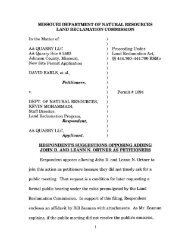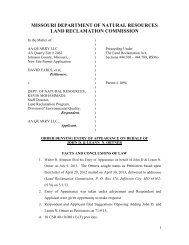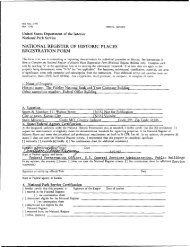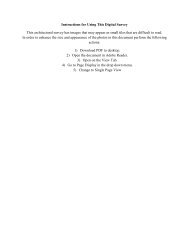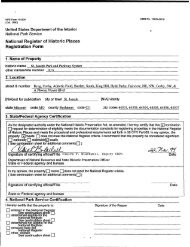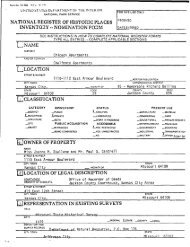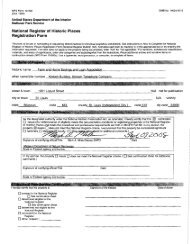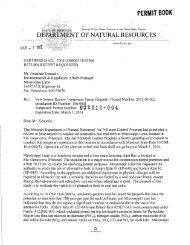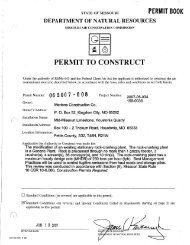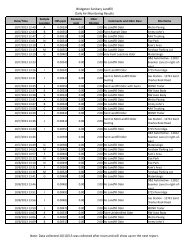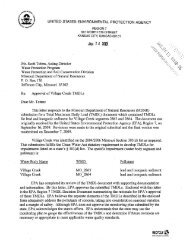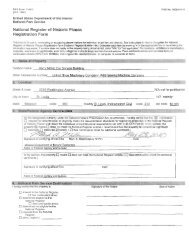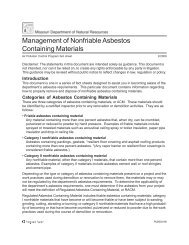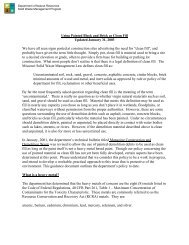Winter 2006 - Missouri Department of Natural Resources
Winter 2006 - Missouri Department of Natural Resources
Winter 2006 - Missouri Department of Natural Resources
Create successful ePaper yourself
Turn your PDF publications into a flip-book with our unique Google optimized e-Paper software.
to 23 volunteers with 10 or more years<br />
<strong>of</strong> service. The volunteers demonstrated<br />
their long-term commitment to the<br />
water quality in local streams by submitting<br />
data to the stream team program<br />
on a regular basis.<br />
Trained volunteer water quality<br />
monitors who received<br />
the Dedicating a<br />
Decade award<br />
include: Jeanelle<br />
Wiley – Crane,<br />
Barbara<br />
Lawton –<br />
Valley Park,<br />
Robert Steiert –<br />
Kansas City, Barbara Duffy –<br />
Camdenton, Gerry Boehm – St.<br />
Charles, Larry Ruff – St. Charles, Ken<br />
Hogue – Lonedell, Dee Dokken –<br />
Columbia, Tim Smith – Springfield,<br />
Daniel Miller – Columbia, Robert Foster<br />
– De Soto, Leslie Lihou – St. Louis, Jim<br />
Rhodes – Glendale, Daniel Hatch –<br />
Licking, Rick Archeski – Grover, Kay<br />
Burke – Walnut Shade, Frank Johnson<br />
– Greenfield, George and Carol Timson<br />
– Salem, Michael and Linda Tanner –<br />
Black, Betsy Blake – Clark, and Mark<br />
Osborn – Columbia.<br />
For more information, call the<br />
<strong>Department</strong> <strong>of</strong> <strong>Natural</strong> <strong>Resources</strong>’<br />
Water Protection Program at 1-800-361-<br />
4827 or (573) 751-1300.<br />
New Online Tour<br />
Reservation System<br />
It is now easier and faster to reserve a<br />
tour <strong>of</strong> the State Capitol. The <strong>Missouri</strong><br />
<strong>Department</strong> <strong>of</strong> <strong>Natural</strong> <strong>Resources</strong> has a<br />
new tour reservation system that can be<br />
accessed through the Internet at<br />
[www.mocapitoltours.com]. This new<br />
Web site will allow visitors to check available<br />
dates and times, and make a reservation<br />
for a guided tour even when the<br />
<strong>Missouri</strong> State Museum <strong>of</strong>fice is closed.<br />
Gov. Matt Blunt made the announcement<br />
about the new system, saying it is<br />
an example <strong>of</strong> how state government<br />
can be more efficient through the use<br />
<strong>of</strong> technology.<br />
Reservations are only required for<br />
groups <strong>of</strong> 10 or more; reservations are<br />
not necessary for groups smaller than<br />
Recycling plastic bottles is good for the environment<br />
and the economy. In the United States, the supply <strong>of</strong><br />
post consumer PET recycled containers continues to<br />
be inadequate to meet the growing demand for recycled<br />
content products. While Canadian reclamation<br />
companies doubled their demand for recycled PET<br />
between 2003 and 2004, demand for the plastic also<br />
increased in the U.S. and China.<br />
PET stands for polyethylene terephthalate, a plastic<br />
resin and a form <strong>of</strong> polyester. The PET bottle was patented<br />
in 1973 by chemist Nathaniel Wyeth, brother <strong>of</strong><br />
American painter Andrew Wyeth. The first PET bottle was<br />
recycled in 1977.<br />
Fourteen 20-ounce bottles =<br />
one extra large T-shirt, or one<br />
square foot <strong>of</strong> carpet, or enough<br />
fiberfill for a ski jacket<br />
Sixty-three 20-ounce bottles =<br />
one sweater<br />
Eighty-five 20-ounce bottles =<br />
enough fiberfill for a sleeping bag<br />
10. In addition to using the Web site,<br />
reservations still can be made by calling<br />
the museum <strong>of</strong>fice from 8 a.m. to 5<br />
p.m. Monday-Friday at (573) 751-2854.<br />
The Capitol is open to the public free<br />
<strong>of</strong> charge from 8 a.m. to 5 p.m. daily.<br />
The reservation system also includes<br />
Caring for Your PET<br />
PET<br />
The average U.S. household generated<br />
38 pounds <strong>of</strong> PET bottles in 2002.<br />
Some <strong>of</strong> the products packaged in PET<br />
containers include s<strong>of</strong>t drinks, juice,<br />
water, peanut butter, salad dressings<br />
and oil, cosmetics, household cleaners<br />
and tennis balls. These products will<br />
usually display the recycled logo with a<br />
PET 1, or PETE 1 designation.<br />
The PET bottle recycling rate rose to<br />
21.6 percent in 2004, for the first time in<br />
nearly a decade, up from 19.6 percent the previous year. The amount <strong>of</strong> PET bottles<br />
collected for recycling in 2004 jumped dramatically to a little more than 1 billion<br />
pounds, from the 4.6 billion pounds <strong>of</strong> PET available for recycling, according to the<br />
National Association for PET Container <strong>Resources</strong> (NAPCOR). It is estimated that 80<br />
percent <strong>of</strong> the U.S. population has access to plastics recycling programs. <strong>Missouri</strong>ans<br />
can find local collection points on the <strong>Department</strong> <strong>of</strong> <strong>Natural</strong> <strong>Resources</strong> Web pages at<br />
[www.dnr.mo.gov/alpd/swmp/rrr/recycdoliststatewide.pdf].<br />
The use <strong>of</strong> post-consumer recycled PET increased 59 percent from 2003 to 2004 to<br />
a record 878 million pounds. Recycled PET can be used to make many new products,<br />
including fiber for polyester carpet; fabric for T-shirts, long underwear, athletic shoes,<br />
luggage, upholstery and sweaters; fiberfill for sleeping bags and winter coats; industrial<br />
strapping, sheet and film; automotive parts, such as luggage racks, headliners, fuse<br />
boxes, bumpers, grilles and door panels; and new PET containers for both food and<br />
non-food products.<br />
Recycling a ton <strong>of</strong> PET containers saves 7.4 cubic yards <strong>of</strong> landfill space. According<br />
to the U.S. Environmental Protection Agency, recycling a pound <strong>of</strong> PET saves approximately<br />
12,000 Btu <strong>of</strong> energy that would have been used to manufacture virgin resin.<br />
Jefferson Landing State Historic Site in<br />
Jefferson City.<br />
For more information, contact the<br />
<strong>Missouri</strong> State Museum at (573) 751-<br />
2854 or the <strong>Department</strong> <strong>of</strong> <strong>Natural</strong><br />
<strong>Resources</strong> toll free at 1-800-334-6946<br />
(voice) or 1-800-379-2419 (TDD).<br />
<strong>Winter</strong> <strong>2006</strong> 15



